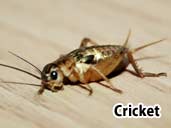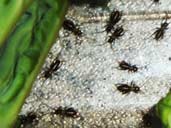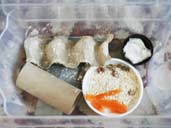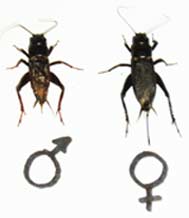 |
 |
Crickets
Name: Crickets. There are two species of Cricket readily available for the use for live feeding and these are commonly referred to as the Brown Cricket (Common House Cricket) and the Black Cricket (Black Field Cricket or sometimes the Mediterranean/African Cricket).
Scientific name: Brown Cricket: Acheta domesticus. Black Cricket: Gryllus bimaculatus
Lifespan: Crickets have a very short lifespan of up to about 8 weeks, with only about 2-3 weeks of that time as a fully grown breedable adult. This short lifespan proves to be the only hassle of keeping a cricket colony, as dead crickets must be removed as soon as possible from the rest of your crickets to avoid disease and the eating of the dead, so it becomes a regular job in the maintenance of your colony.
Benefits as a food
Crickets are readily taken by most amphibians and make a meaty and nutrious meal when gut-loaded with the right diet. Gut-loading is the practice of feeding crickets and other feeder insects with highly nutritious food items that will in turn make the feeder insects more beneficial to the health of your amphibian. Crickets are also suitable for dusting with vitamins and calcium prior to being fed to your pets.
The various life stages of the cricket will offer a wide variety of prey size to offer your amphibians, with newly hatched ‘pin-head’ crickets being suitable for smaller amphibians and fully-grown adults being suitable for larger specimens.
Crickets are easy to keep and cheap to feed which makes them a good, affordable choice to have as a handy food item. The only downside to keeping crickets is their relatively short lifespan, so care must be taken to ensure you have a constant supply available through breeding within the colony. Black Field Crickets are also quite loud as they will chirp in adulthood, so if you would prefer a silent colony then the quieter Brown Crickets are recommended.
Housing
 Crickets can be housed in a Cricket Keeper (available from Reptile shops and online) or a well-ventilated, deep, plastic tub/bin or an aquarium with a mesh lid. Crickets do not climb well on smooth surfaces, so ensure that the sides of the tub are not textured. Air holes should be punched into the lid of the box for ventilation or alternatively cut a large section of the lid out with some sharp scissors and cover the hole with a fine wire mesh or a recycled pair of old tights (pantyhose). No substrate needs to be used, so this makes cleaning a more simple process.
Crickets can be housed in a Cricket Keeper (available from Reptile shops and online) or a well-ventilated, deep, plastic tub/bin or an aquarium with a mesh lid. Crickets do not climb well on smooth surfaces, so ensure that the sides of the tub are not textured. Air holes should be punched into the lid of the box for ventilation or alternatively cut a large section of the lid out with some sharp scissors and cover the hole with a fine wire mesh or a recycled pair of old tights (pantyhose). No substrate needs to be used, so this makes cleaning a more simple process.
They will also require places to hide, so cardboard tubes or egg box bottoms placed in the tub will help them to feel secure.
The tub should be kept dry and in a place where a normal light cycle can be maintained, with around 8 hours of darkness each day.
As Black Crickets will chirp in adulthood, placing the container away from areas that this noise may disturb you is advised.
Feeding
Crickets will eat almost anything, but as you are going to be feeding them to your amphibians it is wise to feed them on foods that boost their nutritional value. Dry foods like oats, bran, grain and flaked fish food should always be readily available, but the addition of plenty of fresh vegetables regularly would give the crickets a good diet. Variety is recommended, but potatoes and carrots are a favourite. They do well on a high protein diet so dry dog or cat food is suitable too. All the food items should be chopped into small pieces to make them easier to consume by the crickets. Calcium and Vitamin dust can added to the dry food to gut-load the crickets, but most amphibians would still require regular dusting to supplement this.
There is no need to add water to the container, as they should be able to source all their water from their food, especially if items like orange, apple or lettuce are a regular in their diet, but if you do prefer to give them something to drink just add a damp sponge or slightly soaked cotton wool to avoid the crickets drowning in a water bowl. Their water should be declorinated or bottled spring water.
Temperature
Crickets should be kept at a temperature around 25 - 30°C (77- 86°F). They can survive at lower temperatures, but will not breed as quickly at temperatures below this. Heat can be provided with a heat mat, but if you would prefer to keep your crickets more cheaply, then placing them on top of a vivarium which as a roof mounted heat source like a ceramic or heat bulb will suffice.
Temperature can also be used to help your amphibians at feeding time, because if you cool your crickets in the fridge prior to feeding then they will be more inactive and therefore easier for your pet to catch.
Breeding
 Crickets are difficult to sex as juveniles, but when they reach adulthood it becomes easy to tell the two genders apart. The female has a ovipositor (egg laying apendage) extending from the rear, which is quite distinctive and is the easiest way to determine the sex of your crickets. The males also have ridges on their wings, while females wings are smooth. This is due to the males wings being used to create the 'chirp' that is the cricket's recognisable mating call.
Crickets are difficult to sex as juveniles, but when they reach adulthood it becomes easy to tell the two genders apart. The female has a ovipositor (egg laying apendage) extending from the rear, which is quite distinctive and is the easiest way to determine the sex of your crickets. The males also have ridges on their wings, while females wings are smooth. This is due to the males wings being used to create the 'chirp' that is the cricket's recognisable mating call.
Adult Crickets will breed quickly if given the right conditions. A breeding container should be placed in the housing to encourage the females to lay their eggs. This can be a plastic tub containing either a simple substrate of damp cotton wool or paper towels or alternatively it can be more natural and contain moist sand or fertilizer free soil to allow the female to burrow before depositing.
This container should be replaced regularly or when it becomes apparent that eggs have been laid. Eggs are white in colour and should be removed to a separate container to be incubated. If the breeding container is kept warm and damp the eggs will hatch in about 10 days.
Other Useful Information
To start a viable cricket colony it is recommended to purchase around 200-1000 crickets, dependant on the frequency that they will be required. It is advisable to leave your colony for a few weeks before starting to harvest them as a live food to allow the breeding process to get started and ensure your supply is sustainable.
Crickets are naturally cannibalistic and territorial, so ensuring that there is always plenty of food available and providing adequate hides should avoid this. Dead Crickets should also be removed as soon as possible from the container as crickets will sometimes eat the dead, which can not only lead to disease, but goes against any of the positive gut-loading that is recommended for crickets that are meant as a live food.
